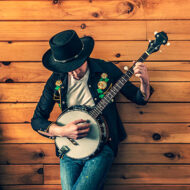Drawing from Life
An Opportunity for Improving Your Drawing Skills

Are you drawing from life? (Photo credit: 123RF.com Image ID: 39635406 Copyright: pressmaster)
Drawing from life is an essential skill for any artist. With the internet, the temptation is to do a Google search for reference photos. I’ll admit that I do it too. It’s just so convenient!
In reality, I work primarily from reference photos. It’s the nature of what I do. Roughly 80% of my commissions for pet portraits are of animals that have already passed on. The owner forwards a handful of their favorite pet photos and I work from those when creating the portrait.
The other instance where I might use reference photos is when I’m drawing animals that couldn’t possibly see in person. Underwater sea life, lions, and tigers. Outside of going to the zoo or on safari, I just don’t have access to them.
But what difference does it make?
First and foremost for my work, the subject in a photo doesn’t move around. Even if I could draw to the caliber of my pet portraits in just five minutes, have you tried getting your pets to sit still for that long, much less retain that precious expression? Also, the lighting in a photo doesn’t change, reflections don’t change, weather isn’t an issue (if you’re doing landscapes), and if you don’t finish your drawing in one sitting, the photo won’t change.
So What’s the Problem?
So far, drawing from photos sounds pretty great, right? So why bother drawing from life? Why not Google what you’re looking for or go out and take a photo of what you want?
Primarily, even with the most high-tech, high-res camera, some distortion takes place. Think about it. It’s impossible for it to not happen. You’re taking a three dimensional image and flattening it out into a two dimensional photo. When you do that, several things happen.
- Perspective becomes slightly skewed
- Spatiality (the relationship between objects) becomes distorted
- Dimension of objects and people become distorted
- Color almost never matches real life
- Value almost never matches real life
Why Your Eyes Reign Supreme
Visual acuity is one of an artist’s greatest tools. If you’re not honing this skill you’re only doing yourself a disservice. Nothing can truly replace seeing something in person. For example, if you’re drawing a person’s portrait, only your eyes can distinguish all of the subtle plains, variations in color, and value on that persons face. While a camera on the other hand will lose much of that detail.

A photo will always flatten an image. Space and perspective can become distorted. (Photo credit: 123RF.com Image ID: 21673639 Copyright: 1markim)
Perspective and spatiality go hand in hand.
When you’re physically in a space observing what’s around you, you see perspective and spatiality as they truly are. A photo will always flatten it. For example, in the photo above, how far behind the man in front is the lady in red? Two feet? Five feet? What about the man in the back?
Color and value will always be distorted by cameras.
It is the nature of the beast. I don’t understand all of the technical details, but in a nutshell it has to do with the camera simplifying what it sees into basic RGB. It will basically try to assign the closest matching color in its ‘palette’, which isn’t necessarily what you see. Have you ever tried to take a picture of a stunning sunset and found that what you got wasn’t as stunning as the real thing? It’s also why nobody can ever get an accurate photo of the Northern Lights. It’s the reason behind why people say, “The photo doesn’t do justice,” to whatever the subject was in real life.
So while in some cases (like mine), it is nearly unavoidable to work with anything but a photo, I do suggest breaking routine and making it a regular exercise to try and draw from life. It doesn’t have to be a full blown masterpiece. Short, 15 minute sketches will do. I know plenty of artists who do this as a warm up before working on commissions. How much information can you capture accurately in a short period of time? It’s more about training your visual acuity and observation skills.
As an artist, why wouldn’t you want that?
.
.
.
This blog contains Amazon Affiliate links. As an Amazon Associate, I may earn from qualifying purchases.


Recent Comments